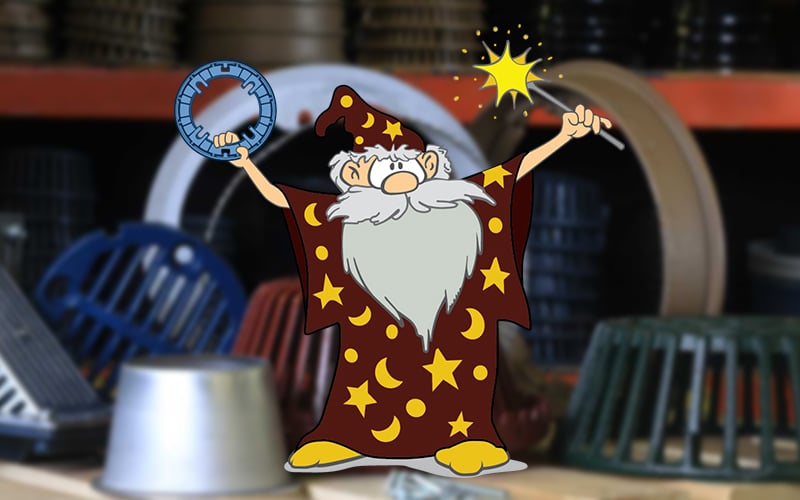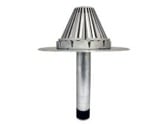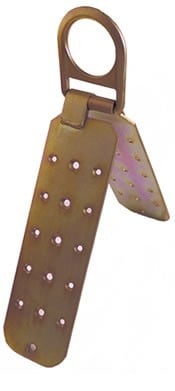 Fall arrest equipment prevents a worker from hitting the ground if they fall over the roof edge. According to OSHA regulations, workers 6 ft. or more off the ground must be tied off to a fall arrest system if there are no guardrails or safety net systems in place.
Fall arrest equipment prevents a worker from hitting the ground if they fall over the roof edge. According to OSHA regulations, workers 6 ft. or more off the ground must be tied off to a fall arrest system if there are no guardrails or safety net systems in place.
Having a fall arrest system prevents fall-related fatalities and injuries. Falls on average kill between 150 to 200 people every year.
A fall arrest system consists of a lifeline and shock-absorbing lanyard connected to a harness. The other end of the lifeline is then connected to an anchor (or tie-off) point. This anchor point offers the resistance necessary to stop a worker’s fall.
In this post, we’ll provide details on OSHA’s anchor point regulations, and recommend how to ensure the anchor points your contractors select meet or exceed these requirements.
OSHA Regulations to Consider When Tying Off to an Anchor Point
OSHA mandates that anchor points meet the following criteria:
- Acceptable anchor points must not be part of or used to support or suspend platforms.
- The anchorage point must be able to support 5,000 lbs. of force per person tied off to it.
While OSHA is explicitly clear on what is required of a fall-arrest anchor point, contractors are left with the question, “How do I tell if something is able to support 5,000 lbs. of fall force?”
Permanent and Temporary Anchorage Points
On a roof there are a number of permanent structures contractors can tie off to, or permanent and temporary anchorage plates that can be installed. Unfortunately, without running stress tests on these anchor points at the specific point of the roof they are connected to, it isn’t possible to accurately calculate what type of pull force they can withstand.
The only way to know for certain is to perform a pull test. To perform one of these tests, you must use a portable pull tester. It attaches to the top portion of an anchor screw, which is secured to the roof substrate. Depending on the model of pull tester, a crank applies upward force on the screw, measuring how many pounds of force are being applied to the screw. You continue the test until the screw breaks free or you are happy with the result.
After you get the rating of one screw, multiply that by the number of screws holding the anchor point in place. This will provide the total force the anchor can withstand.
The main problem with this approach is you need to test every anchor point at its specific placement on the roof because the roof’s structural integrity can change depending on material used and any sort of substrate damage that may exist. In addition, the test itself may weaken or damage the roof substrate.
What is a Contractor Supposed to Do?
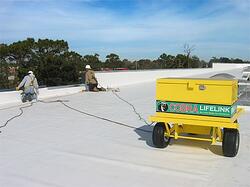 Fortunately, there are alternatives to anchor plates and permanent roof structures. Mobile fall protection carts are designed to provide OSHA-compliant fall arrest.
Fortunately, there are alternatives to anchor plates and permanent roof structures. Mobile fall protection carts are designed to provide OSHA-compliant fall arrest.
A mobile fall protection cart moves around a roof deck with a worker. In the event of a fall, the mobile fall protection cart’s claw or hook is deployed and driven down into the roof substrate, locking the cart in place and stopping the contractor’s fall.
These carts are independently tested on all different types of roofing substrates, including metal (all types and gauges), cement and plywood. Simply match these test results to the roof type you’ll be working on to see whether or not you’ll meet and even exceed regulations.
The mobile fall protection cart test results can easily be made available to inspectors or insurance companies at need to demonstrate OSHA compliance.
Mobile Fall Protection Cart Safety Rules
While these carts offer great fall protection and flexibility, there are some important safety rules to follow when using them:
- Check with the cart’s manual or manufacturer to see how many workers can tie off to one cart. Never tie off more workers than the cart can support.
- Often, these carts come with two different tie-off points—fall arrest and fall restraint. Tying off to fall-restraint points will not deploy the cart’s claw, and as a result, won’t provide the necessary fall protection. Make sure contractors know which tie-off points are which, and how to safety connect to them. Click here for more on the differences between fall restraint and fall arrest.
Contact Hy-Tech Products for More Information
If you have any questions about this topic or fall arrest equipment, please contact Hy-Tech at info@hy-techroof.com or 800-635-0384.
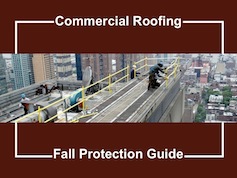
Hy-Tech's Commercial Roofing Fall Protection Guide
An in-depth look at OSHA fall-protection regulations and the roofing equipment you need to stay both safe and compliant. Download this valuable reference guide for free here.

